
After preparing Yucatan style longaniza in my previous post, I wanted to continue the theme with what is probably the best well-known dish from that region: Cochinita pibil.
Cochinita means “small pig”. Pig farming started with the Eurasian wild pig (Sus scrofa), first domesticated in China and Thailand between 10, 000 and 5,000 B.C. Making their way to Europe, these pigs (Sus scrofa domesticus) were brought from Spain to the Americas, first to the Caribbean islands, and from there, to Mexico. It is interesting to note that in the Yucatan peninsula, pork is a very popular ingredient in traditional recipes; this could come from the fact that the Maya in that region and parts of Central America, were not unfamiliar with this kind of meat to begin with. Before the arrival of the Spaniards, they had already domesticated the peccary, from the Tayassuidae, a family of ungulates related to the pig’s Suidae family. Peccaries have a vivid resemblance to pigs, although smaller in general, and always hairy, but with an elongated head and the characteristic round flat nasal disc; although fossils have been found all around the World, peccaries are known only from the Americas after the Miocene, about five million years ago. It is not uncommon to find peccary remains and depictions in Maya sites, in what were residential areas and kitchens, as well as in ritual and burial settings (from: “Peccaries in Ancient Maya Economy, Ideology, and Iconography”, by Diana Fridberg, a thesis in partial fulfilment of the requirements for the degree with honors of Bachelor of Arts, Department of Anthropology, Harvard University, Cambridge, Massachusetts, March 2005.) Currently, there are just a handful of peccary species alive; just by looking at their geographical distribution, the collared peccary, or javelina (Pecari tajacu) and the white-lipped peccary (Tayassu pecari) are the most likely descendants of those that were part of the ancient Maya diet. In the photos below, collared and white-lipped peccaries, showing their pig likeness and shaggy coats that go from white and cream, to darker shades, where grey turns to blue (photos from Wikipedia):
The European pig promptly substituted peccary in Mexican farms and kitchens for the most part. In their natural habitat, the collared peccary is currently considered a stable species, but white-lipped populations are in steep decline; because of their aggressive nature, big group habit, and their need of a large territorial range, they become easily exposed to hunters, and are more vulnerable to urban development.
Pibil refers to the method of cooking in a piib, which is a pit where food is slow-cooked buried in a bed of hot coals and rocks, and sealed with dirt, generally wrapped in banana leaves, used in the Yucatan peninsula and some parts of Central America to this day and since pre-Hispanic times. Because the annatto-based rub recado rojo, sometimes called “pasta de achiote”, is often used to condiment food cooked in the piib, the name “pibil” is given to dishes with that seasoning, even though nowadays many are prepared in a regular oven, over the stove or in this case, as I have praised as the best substitute for the piib, a slow cooker*.
Pork in Annatto Seasoning Tacos –
Tacos de Cochinita Pibil
Printable recipe: Tacos de Cochinita Pibil
Printable instructions: How to prepare frozen banana leaves
Ingredients
For Recado Rojo:
4 tbsp annatto powder (for example, 2 envelopes of Mama Sitas™)
1 tsp dry oregano (preferably Mexican oregano)
½ tsp ground cumin
Pinch ground cloves
½ tsp black pepper
¼ tsp all-spice (pimienta gorda)
¼ tsp garlic powder (not garlic salt)
1 tsp salt
¼ cup sour orange juice (or mix 2 tbsp orange juice, 2 tbsp white vinegar, and a squirt of lime juice)
For Red Onion and Habanero Pepper Condiment:
½ red onion; peeled and sliced very thinly
2-3 habanero peppers, to taste; washed, stems removed and sliced very thinly (handle with gloves)
¼ cup sour orange juice (or mix 2 tbsp orange juice, 2 tbsp white vinegar and a squirt lime juice)
Salt, to taste
3 lb (1.4 kg) pork; preferably assorted cuts, with and without bone, such as shoulder, leg, loin, rib, hocks, etc.
¼ cup sour orange juice (or mix 2 tbsp orange juice, 2 tbsp white vinegar and a squirt lime juice)
3-4 banana leaves, fresh or frozen, or Al foil
Warm corn tortillas
Prepare recado rojo: Place all the dry ingredients in a mixing bowl (photo below, left). Mix thoroughly, then gradually add juice (or mix) and continue mixing, until a uniform paste is formed (photo below, right):
Set aside.
For the meat: I chose boneless pork loin to have lots of lean meat, and added hocks for extra flavour from the fat and bones; I also personally like “cueritos”, this cooked skin will add some jelly-like texture to the mix:

Wipe clean and pat dry all the pieces of meat with paper towels. If using hocks, cut the skin open with kitchen scissors first, leaving the meat attached around each bone (photo below, left). Slice the boneless meat into large chunks, a couple of inches thick (photo below, right):


Place all the meat in a non-reactive container; wearing food-grade gloves, rub each piece of meat with enough of the reserved recado rojo to coat completely:

Add a quarter of a cup of the juice (sour orange or mixture) to any leftover recado rojo in the small bowl (photo below, left), and pour this over meat (photo below, right):


Cover meat and allow to marinate in the fridge for at least four hours, but preferably overnight.
Prepare banana leaves (skip this part if using Al foil): If using frozen banana leaves (photo below, left), place in the fridge to thaw the night before. When ready to start cooking, place a tall pot or colander upside-down in the centre of the kitchen sink (photo below, right):


Set a cutting board on top of the colander or pot; wash the banana leaves, one by one, by placing on the cutting board, washing with running water and gently rubbing with a clean cloth, while moving and folding the leaf to wash all the surface (photo below, left). Flip and repeat with the other side. Extend a kitchen towel on the counter, and place the clean banana leaf on top; dry with paper towels, flip and dry the other side (photo below, right):
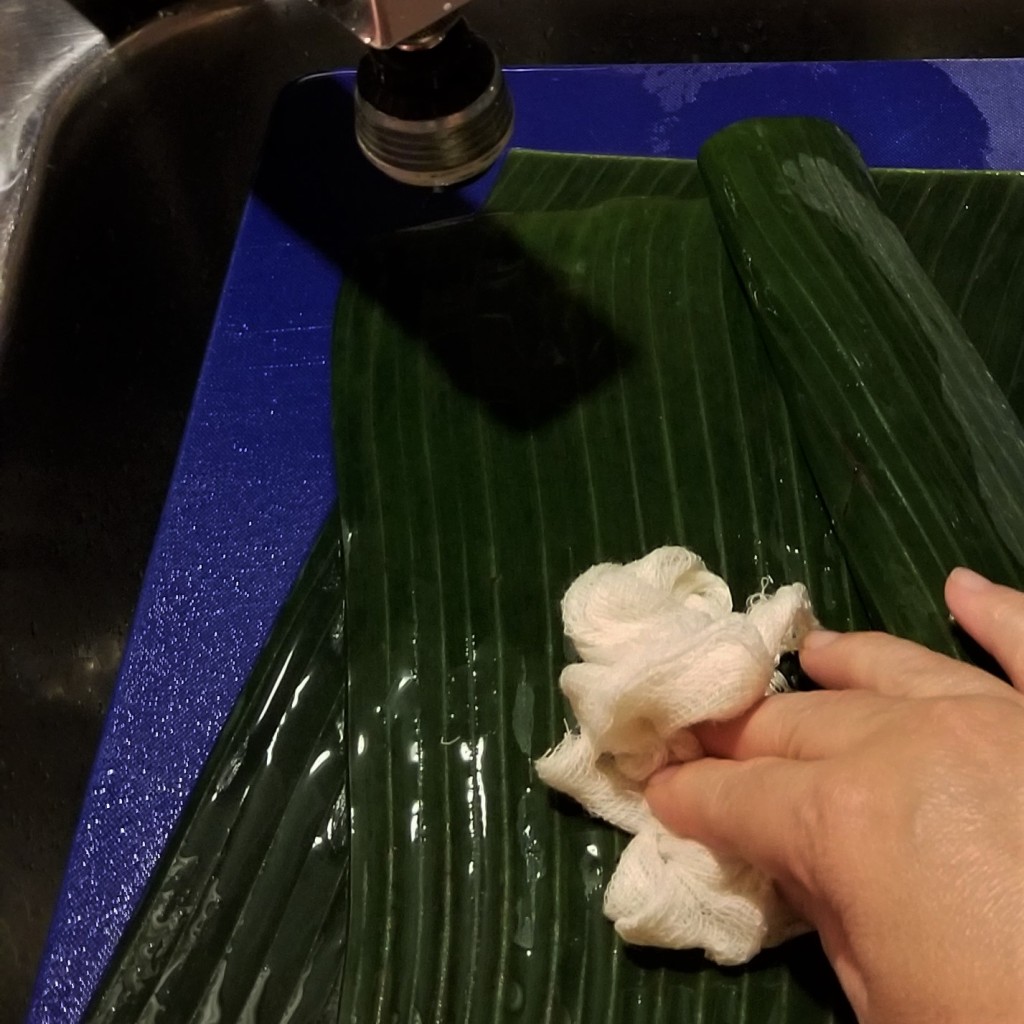
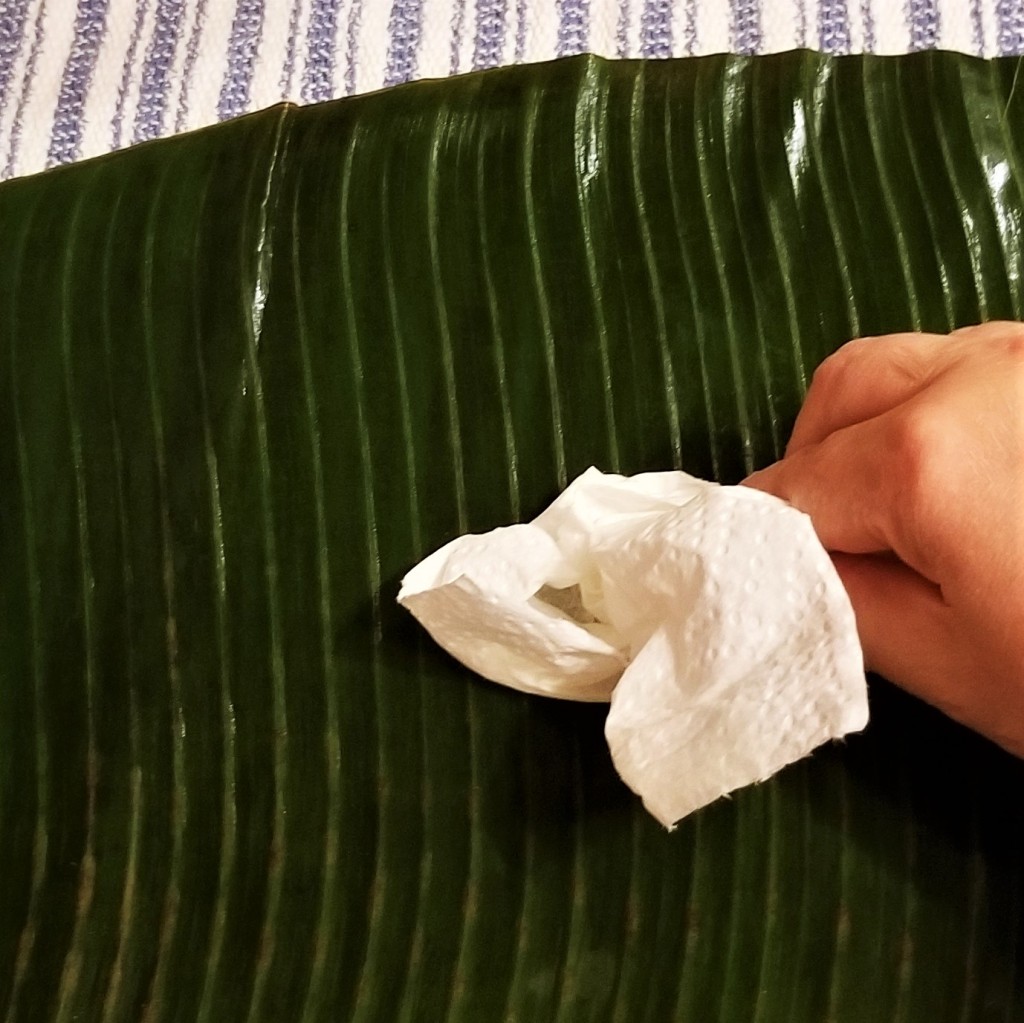
Repeat with the other leaves. I only needed three long pieces for this recipe, and I used about half of a one pound (454 g) package. At this point, the leftover leaves may be wrapped with a towel or placed in a large plastic bag and kept in the fridge for a couple of days, for another application. Before using, the leaves must be roasted to make them pliable; place a baking sheet on the stove over medium heat. Run the leaves over, with the smooth side facing up; the surface will quickly become shinny, as shown below, and the leaf will be pliable:

Do not over cook or they will burn and become brittle again. Repeat with the other leaves.
Assemble the dish for slow cooking: Line the bottom and sides of the slow cooker with the roasted leaves, smooth side down (or use long strips of Al foil instead, shinny side up), leaving a good length over the rim of the slow cooker, to fold over. Place the marinated meat inside:

Pour any remaining marinade in the container over the meat (photo below, left). Fold banana leaves (or foil) over the meat, to close it like a package. Pushing the wrappings away from the wall of the slow cooker, pour about half a cup of water at the bottom of the pot, for extra moisture during cooking (photo below, right):
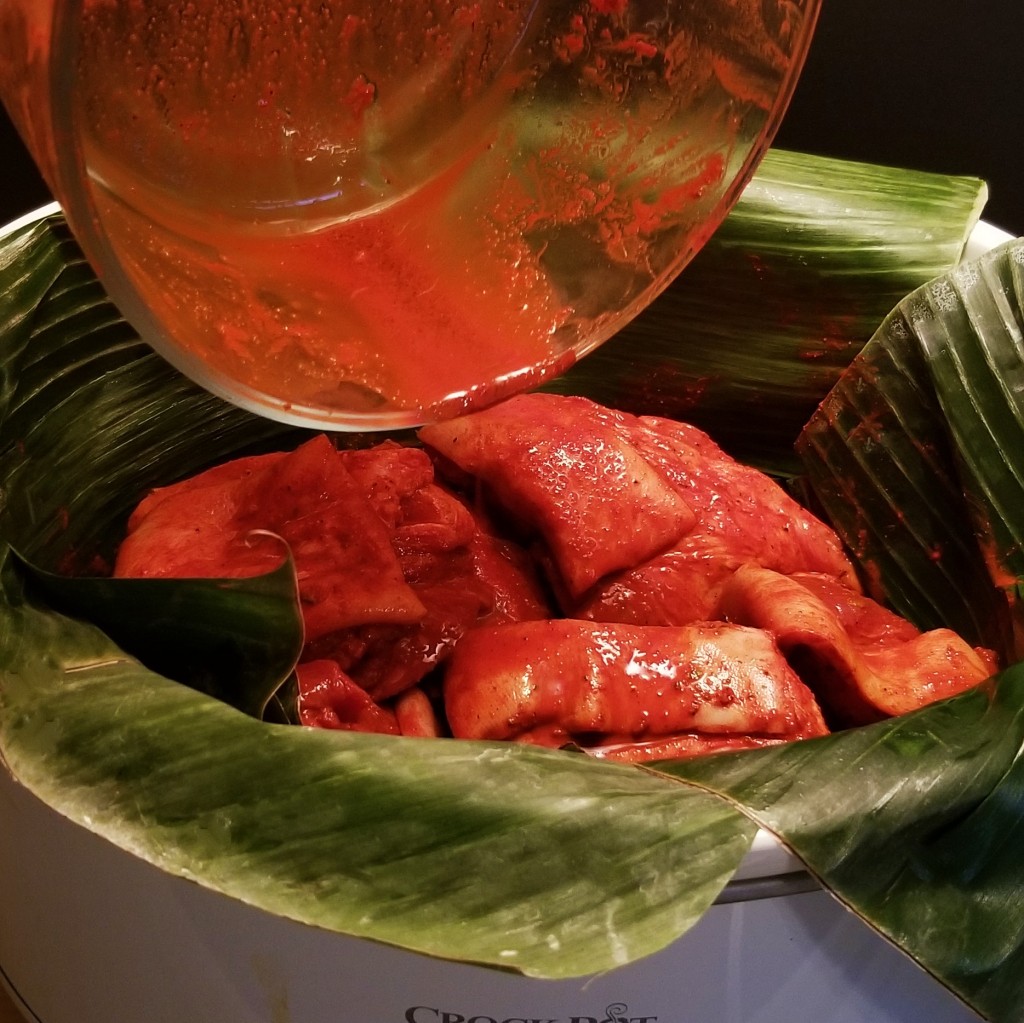

Place lid to close, and turn on the slow cooker on LOW for 8 hours, or HIGH for 5 hours (I used the lower setting.)
Meanwhile, prepare spicy condiment: Place sliced red onions and habanero peppers in a non-reactive bowl or bottle (photo below, left); add salt to taste, and a quarter of a cup of sour orange juice (or vinegar/juice mix, photo below, right):


Mix thoroughly and set aside.
Finish meat: After the cooking time is completed, turn off slow cooker, and remove cover. Carefully open the wrappings (photo below, left). Check doneness with a fork; the meat should flake easily and fall off the bone (photo below, right):


Transfer to a serving plate:

Assemble tacos de cochinita pibil: By simply shredding some meat onto warm tortillas and topping with the spicy condiment, the delicious meat becomes the classic delight that is tacos de cochinita pibil (also pictured at the top of the post):
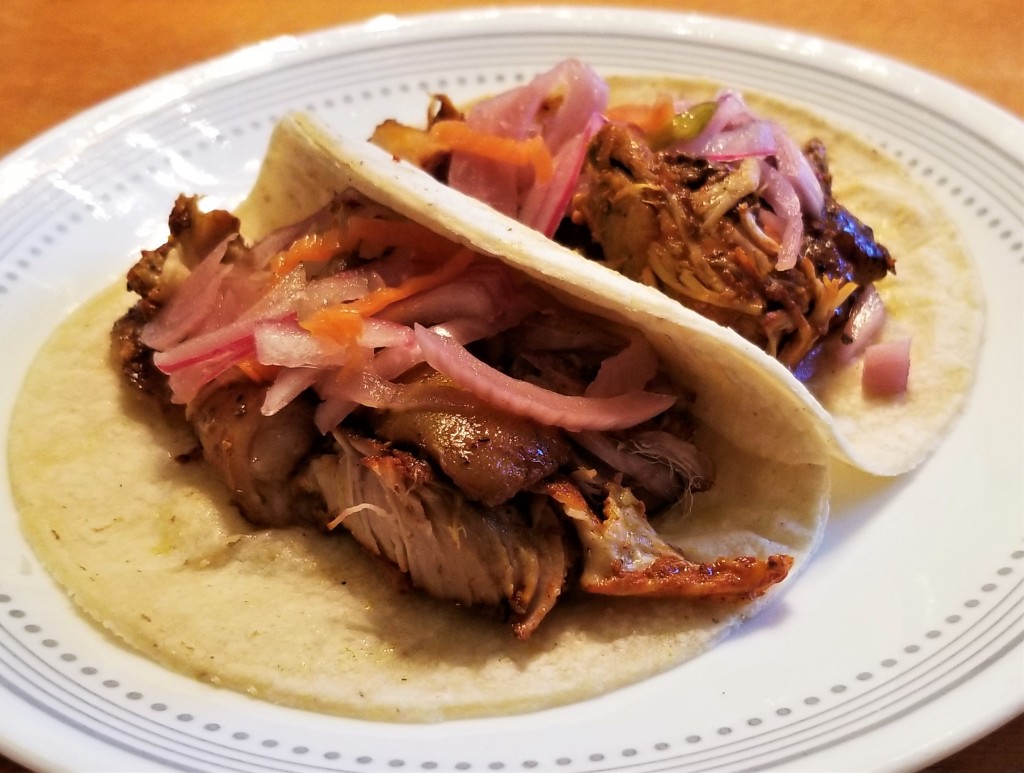
The meat was so juicy and flavourful that it was hard not to devour it all up from the plate! Once shredded onto the tortilla, with the tangy and spicy punch of flavour from the condiment, it took just a first bite to alleviate the craving, and understand why tacos de cochinita pibil are one of the all-time favourites not only in the Yucatan peninsula, but all around Mexico.
FUN FACT: Tacos de cochinita pibil were featured on volume two of the “Taco Chronicles” on Netflix.
* For your convenience, click on the images below for products available on Amazon™. The classic Crock Pot™ on the left is the same as mine, used in this post. The Instant Pot Duo Crisp Pressure Cooker™ on the right, is currently the top item on my wish list (*sigh*, it not only slow cooks, but it pressure cooks, sautés, steams, does sous vide, warms up, air-fries, roasts, bakes, broils and dehydrates!). DISCLAIMER: Any reviews included in this post are my own, for items I have purchased (or want to!), not provided by any company; as an Amazon Associates Program affiliate, I might receive a commission for any purchases originated from the links below, at no extra cost to you:
I am sharing my recipe at Thursday Favourite Things #462, with Bev @ Eclectic Red Barn, Pam @ An Artful Mom, Katherine @ Katherine’s Corner, Amber @ Follow the Yellow Brick Home, Theresa @ Shoestring Elegance and Linda @ Crafts a la Mode.
I am bringing my tacos to Full Plate Thursday #507 with Miz Helen @ Miz Helen’s Country Cottage.
I am joining Fiesta Friday # 351 with Angie @ Fiesta Friday, this week co-hosting with Laurena @ Life Diet Health.
I am bringing my recipe to What’s for Dinner? Sunday Link-Up # 286 with Helen @ The Lazy Gastronome.

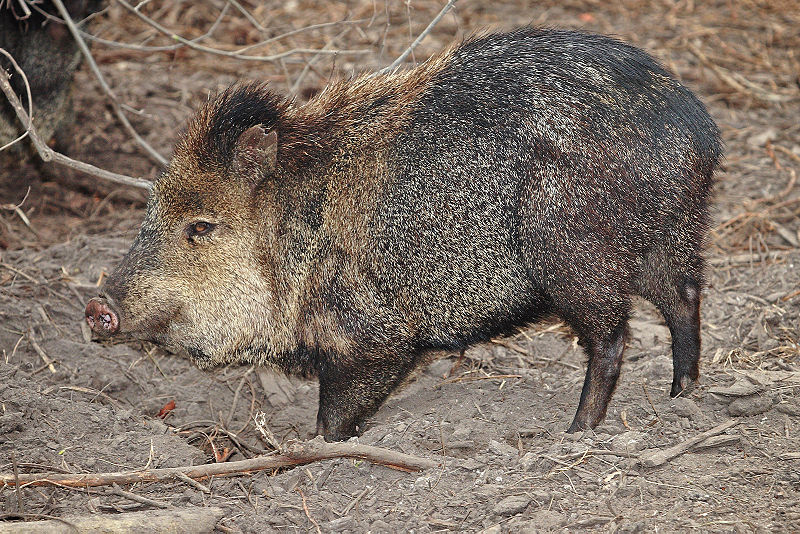












Wow, Irene, you are truly a genius. This post has everything: history, culture, flavor, love of life. I feel inspired and expanded by your generous gifts of storytelling and delicious recipes. Kudos!
LikeLike
Thank you so much, Victoria, so happy you liked this story, you are so kind!
LikeLike
Pibil was our absolute favorite in Mexico! Thank you, I’m so excited to try this recipe. I’ll check our local Mercados for banana leaves and the spices.
LikeLike
Awesome, I hope you like it, Rebecca!
LikeLiked by 1 person
I learn so much reading your posts Irene. The piib sounds a lot like a Maori hangi, or Polynesian umu— hardly surprising I guess.
LikeLike
Yes, it is very interesting how this subterranean technique made up for the lack of ovens.
LikeLike
Irene this is beautifully detailed and now I need to find banana leaves for my slow cooker! I will try this recipe substituting the pork for jackfruit to make it vegan – how exciting! Thanks so much for linking up and sharing this with us at Fiesta Friday. Enjoy the Fiesta!
LikeLike
I have tried pre-cooked jackfruit and recado rojo, but never starting with raw jackfruit, that sounds exciting, Laurena, let me know how it turns out. Thank you for hosting FF!
LikeLiked by 1 person
Yum Irene! I love cochinita pibil!
LikeLiked by 1 person
Taco Time!
LikeLiked by 1 person
Wonderful recipe Irene. I did wonder how you were going to link it to the prompt 😀 thanks for joining in
LikeLike
Hehe, those hairy critters were just the perfect ambassadors, thank you for the prompt!
LikeLiked by 1 person
Those peccary look very sweet, Irene. Enough to turn me vegetarian. 🙂 I realise though that you weren’t cooking with them. Thank you for telling us about them.
Your dish does look delicious. I do eat pork from time to time.
LikeLike
I know, peccaries are now endangered species, so definitely not foodstuffs, especially the red (baby peccary)
LikeLiked by 1 person
This looks amazing! It is a process but well worth it.
Javelinas are found in the western US – funny little critters.
Melissa | Little Frugal Homestead
LikeLike
Cochinita pibil is really a delightful dish. Those peccaries sure are cute. Thank you for your comments, Melissa!
LikeLiked by 1 person
Maybe I’m imagining things but I think I can actually smell this! Fantastic recipe…full of tradition, aroma and flavor!
LikeLiked by 1 person
I hope you get to not only smell, but taste it sometime, it is truly delicious, thank you so much!
LikeLiked by 2 people
I have come to trust your recipes totally. On a recent trip, April 2023, I had the pleasure of participating in the entire procedure of cochinita pibil at a little home. It left me favorably impressed and I was pleased to see that you had posted a recipe. I normally create a spreadsheet and compare multiple recipe ingredients to get a baseline but I can tell from reading this that this is all that I will need. Although ours was cooked in the ground in the sealed metal container, I realized that a slow cooker, a roasting pan covered with aluminum foil,or a Le Creuset dutch oven would all work , oven or slow cooker, that is. I only wish that I could share the videos with your and your followers. One day I may download to YouTube and if so, I will update this comment with a link.
LikeLiked by 1 person
Thank you so much for your kind comment, Jay! It means a lot to hear that my recipes and posts do justice to the original dishes I feature. I would love to hear how your batch turns out, and I will for sure share your link in my blog if/when you play it on YouTube.
LikeLike
Well, you motivated me to learn my Mac’s iMovie app so that I could create and share the video with you for my recent cochinita pibil experience. Here is hoping this link works. Best regards.
LikeLiked by 1 person